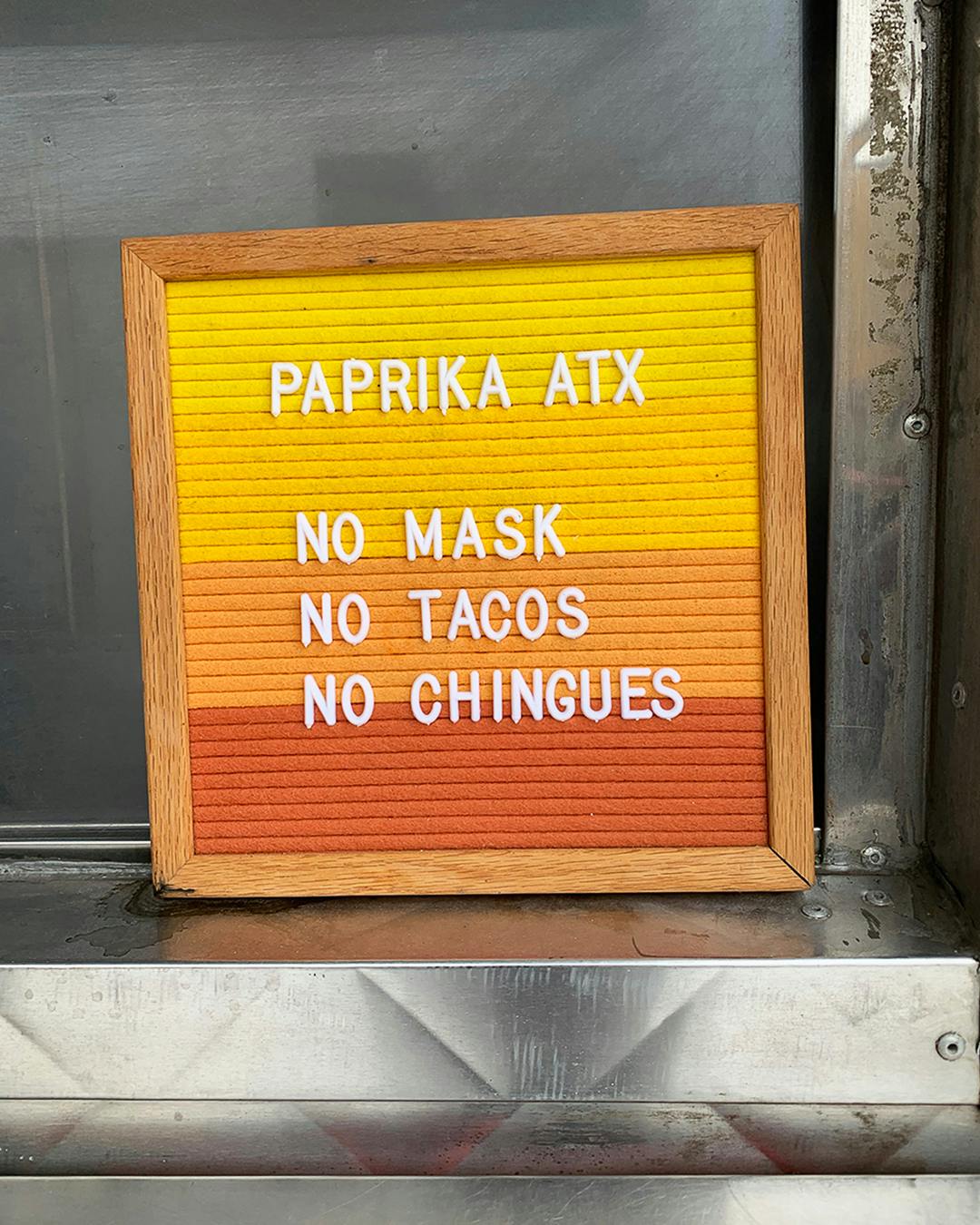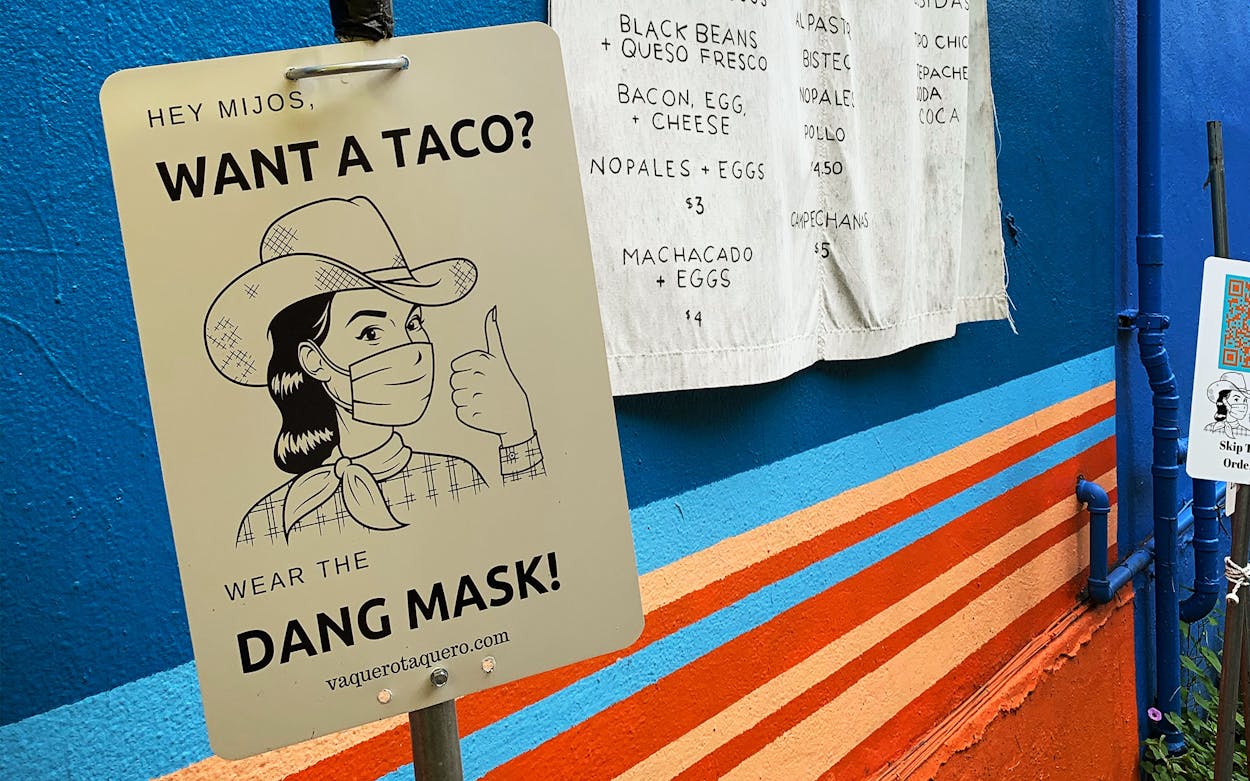On the afternoon of March 2, Texas Independence Day, a small crowd gathered at Montelongo’s Mexican Restaurant in Lubbock to hear Governor Greg Abbott speak. Owner Rudy Rosales, whose grandmother, Petra, opened Montelongo’s in 1972, didn’t know what the televised statement would concern, but he was excited. “You don’t say no to the governor,” he said. Mariachis serenaded Abbott and his staff as they arrived; neither the governor nor most of those present, including members of the Lubbock Chamber of Commerce, wore masks. Just after 2 p.m., at a podium under a welcome sign and a black and white photo of Petra, Abbott announced the end of coronavirus restrictions in Texas.
“It is clear from the recoveries, vaccinations, reduced hospitalizations, and safe practices that Texans are using that state mandates are no longer needed,” he said. “Businesses don’t need the state to tell them how to operate.” Effective March 10, Abbott continued, masks will no longer be required in public, and all businesses can operate at full capacity. “It is now time to open Texas 100 percent,” he declared to cheers and hearty applause. The governor went on to urge “personal vigilance” against the virus, which has killed more than 44,000 Texans.
The news was swiftly condemned by public health experts, with CDC director Rochelle Walensky warning of an imminent spike in COVID-19 cases. “We stand to completely lose the hard-earned ground we have gained” as Texas and other states lift restrictions, Walensky said last week. Abbott didn’t consult three of his four medical advisers before his announcement.
The policy change puts Latino service workers, who have been disproportionately hard-hit by the virus, in an impossible situation. Just under 40 percent of Texans are Latino, but Latinos account for 46 percent of the state’s COVID-19 deaths. Line cooks and agricultural workers are more likely to die of the virus than are people in any other profession, a new University of California-San Francisco study found; delivery drivers and bakers—other jobs heavily populated by Latinos in Texas—are also at high risk.
In Lubbock, the staff of Montelongo’s is well aware of these dangers. Since the pandemic began, Rosales has been paying the restaurant’s longtime cook, an elderly woman, her full salary so that she doesn’t have to risk her life by working. It’s stretching his already tight budget, but Rosales says he feels a responsibility to protect her. “She’s worked here for 45 years and promised my grandmother that she was going to work here until she died,” Rosales said. “So I’ve been paying her for almost a year now to stay home.”
Not everyone can afford such luxury. In the days since a fully vaccinated Abbott announced the end of the mask mandate, made at a time when only about 5 percent of Texans had been fully vaccinated, food workers began to take their own stands on the issue. Most restaurants announced they would continue to require masks, even in the face of adversity. Rosales says he is still consulting with his staff about what, if any, policy changes will be made, but he is more than likely to ask customers to wear masks and he isn’t planning on opening at full capacity. Curbside pickup has performed well for Montelongo’s, he said, and the restaurant is open at only 40 to 45 percent capacity. Rosales is also adamant that the Latino community needs to take a proactive approach to defending and caring for itself. “Good friends of mine and good customers have passed away from the virus out of stubbornness from not wanting to go to the doctor,” he said.

From El Paso to Brownsville and Laredo to Amarillo, restaurants are determined to continue protecting staff and customers while the pandemic rages on. Owners and chefs have posted messages to this effect on Instagram, the Mexican food industry’s preferred communication platform. I have also received myriad text messages that read, in one form or another, “We’re not going to change a thing.” Staff and customers will continue to wear masks, say most restaurant operators.
A line cook, who recovered from COVID-19 and works at a Mexican restaurant in North Texas, spoke with Texas Monthly on the condition of anonymity because, at the time, ownership and management hadn’t discussed changes to their mask policy. The cook feared retaliation from his bosses. He said he was “super shocked” by the news, calling the ending of the mandate and the unfettered opening of all businesses “a little too soon. … There will be violence.” Ownership and management have since decided to keep their previous policy in place. As a result, the line cook is thankful for the leadership of his executive chef, managers, and the restaurant owners who have pledged to act as a buffer between staff and potentially unruly customers.
In Dallas’s Bishop Arts District, CocoAndré Chocolatier & Horchateria co-owner Cindy Pedraza and staff have been powering through the pandemic by taking to-go orders and limiting indoor capacity to four customers in a tiny space that would strain to hold more than that. Staff wear medical-grade masks under fabric coverings and interact with patrons from behind a clear barrier placed on the front of the counter. If she had the money, Pedraza says, she’d love to provide N95 masks for customers. Unfortunately, the family-run business doesn’t have the budget for that. “I’m not Walmart or Target,” Pedraza said. “I can’t afford these little details for you to buy four dollars worth of chocolate in my shop.”
Ahead of Valentine’s Day, CocoAndré’s busiest time of year, one of the staff members tested positive for COVID-19, exposing the team. The chocolatier closed for eleven days to deep-clean and isolate. During that time, Pedraza reimbursed her eight employees for the hours they would have worked while the boutique lost money.
Mayra Dwinal, Pedraza’s sister, works the counter and interacts with customers. She speaks to the mental health toll of the pandemic on business owners and retail and food workers. “You’re expected to continue with your day as if nothing happened. But it does shake you up because people are confrontational. They can be ugly,” Dwinal said, recalling customers who didn’t want to wear a mask. Difficult interactions have left Pedraza with trembling hands and rushes of adrenaline that were difficult to recover from, she said. Prior to the pandemic, food service workers already struggled with mental health challenges at a higher rate than salaried employees; the crisis has only exacerbated those concerns. When Abbott announced the end of the mask mandate, Pedraza said, she and her staff felt that they’d lost “a person in their corner.”
It’s been worse at Picos, a Mexican restaurant in Houston. According to a Houston Chronicle report, people have been sending in hateful messages and calls threatening to have Immigration and Customs Enforcement investigate the restaurant’s staff, says co-owner Monica Richards—all because Picos announced it would continue to require masks. “For people to be negative toward us for trying to remain safe, so that this doesn’t continue to happen, just makes zero sense to us,” Richards told the Washington Post.
Margarito Perez, co-owner and taquero of the Paprika ATX truck in Austin, hasn’t received threats, but he does have similar worries. “I think [lifting the restrictions] is premature and wildly irresponsible,” Perez said. “We will continue to require masks when not eating.” His statement is reinforced by a sign Perez places on the rig’s ordering counter. It reads “No Mask, No Tacos, No Chingues.” (I’ll leave the colorful translation up to you, reader.)
In San Antonio, Ray’s Drive Inn, the home of the puffy taco, is keeping its interior closed and will continue carhop and takeout operations, says night manager Nathan Morales. Server Melissa Valdez is grateful for the restaurant’s decision to remain drive-in only, but she still worries about passing the virus to her relatives. “I am very concerned because I do have family that live with me that are older, and I have siblings that have passed away because of COVID,” Valdez said, adding that she believes the government is opening businesses too fast in part to take advantage of the surge in sales that comes with spring break. However, she would be fine with opening up businesses at 100 percent if the mask mandate were left in place.
Kristal Marentes of Elemi in El Paso, one of the state’s hardest-hit regions during the pandemic, worries that the end of the mask mandate could bring a return to the staggeringly high infection rates the area saw in October. Back then, El Paso County recorded a peak of more than 1,600 new cases per day. Elemi will continue to require masks, and the employees are hoping customers will comply. “It’s literally a matter of life and death for something that is so simple,” Marentes said. “It’s very easy to just wear your mask. We’re not asking for anything. We’re not asking for an upfront payment of any type of money. It’s just to wear your mask.”
Emiliano Marentes, Kristal’s husband and Elemi’s executive chef, has similar concerns. During El Paso’s spike last fall, businesses were forced to close, and he fears that could happen again. The only thing that could possibly prevent a deadly increase in COVID cases is immediate and total vaccination, Emiliano told me. He also fears that the end of restrictions will cause employees to get sick and risk infecting their family members. “Those are the things we don’t think about. We’re worried about our employees who are high-risk individuals,” he said. “We’re worried about the high-risk parents of employees.”
The end of the statewide mask mandate comes less than a month after the Texas power grid failed during February’s winter storm, leaving four million households without electricity and at least 58 people dead. While only weeks ago, Texans clutched blankets and lit fires to keep warm, businesses near the Gulf Coast are now bracing for a potential deluge of partygoers. Over a Zoom video call, Joanna Hernandez, co-owner and general manager of Taqueria El Ultimo Taco in Brownsville, near South Padre Island, said Abbott’s announcement comes too soon. The restaurant will continue to operate at 75 percent occupancy and require masks, even through the spring break increase in business. Hernandez expects to see a 25 to 30 percent spike in sales during the holiday, and she’s scared that the influx of tourists will put her workers at risk.
She recalls watching in horror as crowds of vacationers packed the beach at South Padre Island last September, during one of the virus’s spikes in the Rio Grande Valley. She and her husband, co-owner Rolando Curiel, were astonished at the crowds. The sight was less than a month after Curiel’s sister, who also worked at the restaurant, died of COVID-19. Curiel describes her as his “righthand man,” saying her help in the business was invaluable. The 64-year-old woman took every precaution and stayed home from work, but the virus still found her. Her husband and children also tested positive for COVID but recovered.
Now, as spring break approaches, Hernandez and Curiel feel a looming sense of dread. They fear the crowds will be even bigger than last year. The end of the mask mandate feels personal, Hernandez explains, since her sister-in-law’s death. “It’s not until COVID happens to you that you realize to what extent it could affect you,” she says. “It hurts. It’s too soon.”








